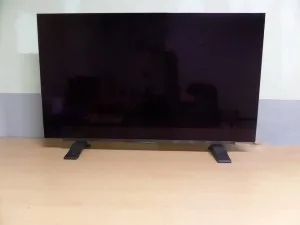On Christmas Eve, Primeview USA Inc. (New York, NY) announced it was introducing an OLED monitor targeting industrial applications. The product is being introduced in partnership with LG Display (LGD) and, of course, uses LGD glass. The initial product is a 55” industrial display, model number PRV55OLED, which will be available for delivery in Q1 2014. The display has FHD (1920 x 1080) resolution. The unit will be first shown publicly at Integrated Systems Europe (ISE) in Amsterdam February 10 – 12 in the HDBaseT booth, Hall 7, booth 7E-190. After that, a demo unit will be brought to Primeview’s New York office for more demonstrations to US customers.
Primeview’s goal with its industrial OLED monitors is to bring cutting edge, broadcast quality color technology to the broadcast, medical, command and control, industrial and signage verticals.
“Working extensively with plasma displays has allowed Primeview to build a strong relationship between our advanced R&D team in Korea and LGD. Together, we are excited to be releasing the first OLED display to the industrial market. As we introduce large format OLED into the workflow, OLED will expand into a video wall version in late Q2 of 2015. Following suit are the 55” and 65” 4K resolution displays”, said Shay Giuili, CEO and founder of Primeview USA.
Highlights of OLED Technology from LGD and Primeview:
- The lightweight panel leads to lightweight displays.
- Serves the eco-friendly footprint with low energy consumption.
- Viewing angle of 178⁰. With the same viewing angle portrait and landscape.
- The self-illuminating pixels allow for a nearly perfect black level.
- (Near) Infinite contrast ratio for high image quality.
- .001ms response time compared to a 5ms LCD response time.
One thing emphasized by Primeview is in an OLED display, the brightness, color and contrast do not vary with viewing angle, unlike LED LCD displays. At high viewing angles, these visual properties of LCDs can differ from the visual properties of the display when viewed straight on. In addition the contrast, which is limited to about 5000:1 in the best LCDs, is near-infinite in an OLED panel because the pixels can be shut off completely with no visible emission.
I had a chance to talk to Primeview USA’s VP of sales, Chanan Averbuch, and Director of Technical Services, Yossef Jackson, about this new technology. They say Primeview has been working with LGD for two years now to develop the industrial-grade displays. The basic glass is targeted at consumer systems and custom resolutions are extremely expensive to develop, so Averbuch does not see any size/resolution combinations other than the ones in high volume consumer applications for the foreseeable future. In particular, he does not foresee WUXGA (1920 x 12000) panels that are sometimes desired by the production and post-production industries.
According to Averbuch, Primeview is accepting orders now for delivery in January 2015 at an MSRP of $14,600. He says that OLED yields are currently about 40% and as the yields go up, the prices for the panels will come down. Primeview does not maintain an inventory of standard products and all orders are accepted “project based” with delivery times of 6-8 weeks. This allows customization of the panels to meet the needs of a customer. For example, the OLED displays can be calibrated for any desired white point.
Other products on the time line include other sizes, a 4K version and a version that will be tileable. The tileable version should be available in mid-2015 and the 4K version in late 2015 or 2016. According to Averbuch, the studios are waiting expectantly for the tileable version so they can replace plasma displays for on-set use. In the mean time, he expects studios to use OLED displays for on-set single monitors and for production/post-production applications.
He said another application category Primeview is working with is military applications. He also foresees tiled OLED displays replacing both tiled LCDs and rear projection cubes in control rooms, once they are available. While a few high-end retailers have expressed interest in the OLED displays, he said that, in general, the digital signage market is very price sensitive and he expects it to wait till the prices on OLEDs come down.
One of the driving forces behind the use of OLED panels is their wide viewing angle and the fact that the viewing angle is the same whether the panel is used portrait or landscape. Another driving force is the very long lifetime of OLEDs – Averbuch said it was about 60,000 hours to 50% brightness and can be longer in applications such as post-production where the displays are typically run at lower initial brightness.
Primeview has put a PDF file online discussing the differences between OLEDs and LED-LCDs.
I won’t be at ISE this year, but when these displays come to New York, I’ll make sure I get a demo. – Matthew Brennesholtz


